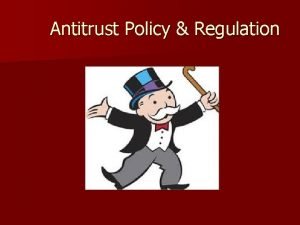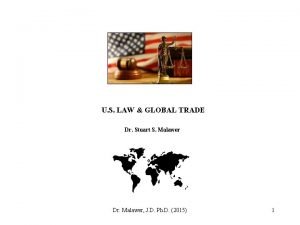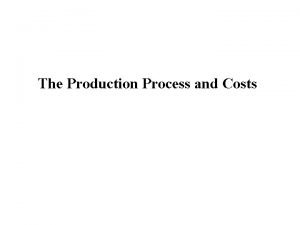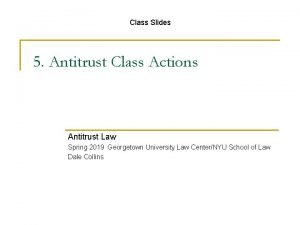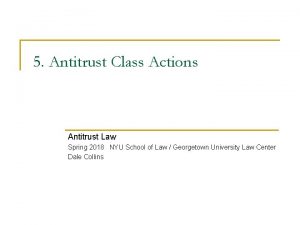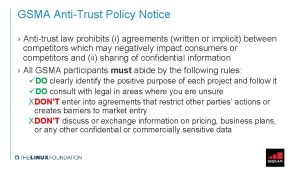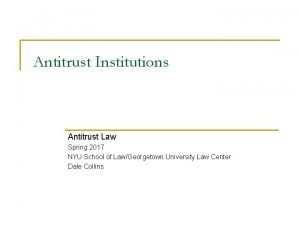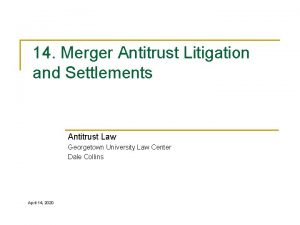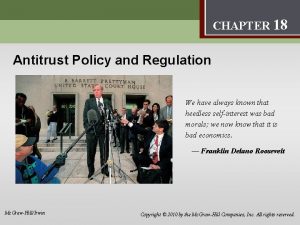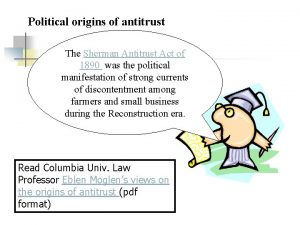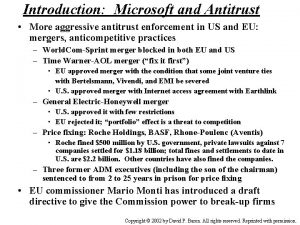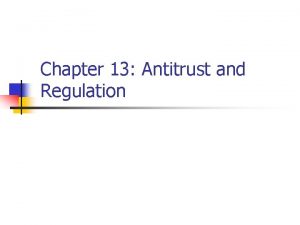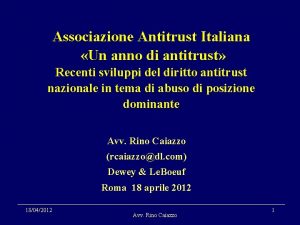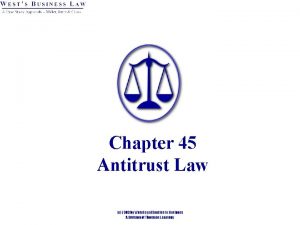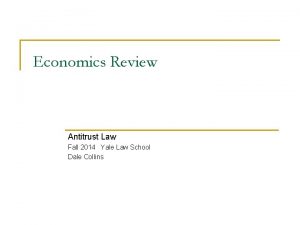Legal Framework of U S Antitrust Law Douglas


























- Slides: 26

Legal Framework of U. S. Antitrust Law Douglas H. Ginsburg Moscow, July 8, 2010 1

Introduction • The purpose of antitrust (competition) law is to increase consumer welfare by making sure businesses compete • Law prohibits certain – Agreements between businesses – Activities by a single business, and – Mergers If they make competition less likely 2

Economic Background • Perfectly competitive market: – Price of every good is the cost to manufacture the last unit (marginal cost) – Every person willing to pay that price is able to buy it Hovenkamp, Federal Antitrust Policy § 1. 1 a 3

Economic Background Major harm of a monopoly = deadweight loss Deadweight Loss Pmonopoly Pcompetitive Marginal cost Loss to people who would buy a product at the competitive price but cannot because the price has been raised above marginal cost Demand Qfixed Qcompetitive 4

Economic Background • Two types of activities can alter competition – Coordinated activity of two or more firms • By contract • By tacit agreement – Activity of a single firm 5

Coordinated Activity: Horizontal • Coordinated activity (agreements) between firms at same level in chain of distribution, for example, retail • Called horizontal conduct and unlawful if: – – Fixing prices or quantity Dividing a market, for example, by territory or customer Mergers Trade associations (legitimate but can violate laws if used to monopolize) – Standard setting (legitimate but can violate laws if used to monopolize) 6

Coordinated Activity: Vertical • Coordinated activity (agreements) between firms at different levels in chain of distribution • Called vertical conduct. For example: – Retail price maintenance – Coordinating distribution (e. g. , diving the market geographically) 7

Single-Firm Activity • Some conduct by a single firm demands scrutiny, even absent coordination with other firms – Predatory pricing – Tying – Exclusive dealing – Refusals to deal 8

Market power • Market power is a firm’s ability to increase profits by – Reducing output and – Pricing above marginal cost. 9

Market power • Market power is a firm’s ability to increase profits by – Reducing output and – Pricing above marginal cost. Deadweight Loss Pmonopoly Pcompetitive Marginal cost Demand Qfixed Qcompetitive 10

Defining the market • A relevant market is the smallest grouping of products for which a monopolist could profitably reduce output and increase price substantially above marginal cost. • A grouping of sales is not a relevant market unless both the elasticity of demand the elasticity of supply are sufficiently low. This is simply another way of saying that (1) customers must not be able to find adequate substitutes easily in response to the price increase; and (2) other firms must not be able to enter the market so as to compete away sales by asking a lower price. 11

Market definition example Ford cars American passenger cars All motor vehicles (including motor bikes, etc. ) 12

Market definition example Ford cars Imagine Ford increases the price of its cars by 5%. Many customers would turn to other American brands, e. g. , Chevrolet. As a result, the price increase would probably not be profitable for Ford, so this market is too narrow to be the relevant market. 13

Market definition example American cars Imagine a monopolist increases the price of all American cars by 5%. Many customers would turn to non-American, e. g. , Japanese, cars so this is probably too narrow of a market as well. 14

Market definition example Passenger cars Imagine a monopolist increases the price of all passenger cars, from all countries, by 5%. Few consumers would turn to motor bikes and entry into car making is difficult and would take a long time; therefore the monopolist probably could profitably sustain the price increase, and “passenger cars” is the relevant market. 15

Market definition example All motor vehicles Imagine a monopolist increases the price of all motor vehicles (including motor bikes) by 5%. The monopolist could profitably sustain the price increase. The relevant market, however, is the smallest such grouping. Therefore the relevant market is still “passenger cars” rather than “all motor vehicles” because “passenger cars” is a smaller group. 16

Defining the market Market definition is based upon evidence: (1) “that buyers have shifted or have considered shifting purchases between products in response to relative changes in price or other competitive variables; (2) “that sellers base business decisions on the prospect of buyer substitution between products in response to relative changes in price or other competitive variables; (3) about “the influence of downstream competition faced by buyers in their output markets; and (4) about “the timing and costs of switching products. ” Merger Guidelines § 1. 11 17

False precision & administrability • Defining the market assumes knowledge of consumers’ responses to changes in price. This type of data is rarely available directly, so economists create models to predict consumer responses. 18

False precision & administrability • • These economic models report detailed results but the results may not be as precise as they appear because the models must rely upon uncertain assumptions. For example, many models rely upon estimations of a firm’s marginal cost. Marginal cost, however, is an economic construct that is not reflected in firms’ accounting records. Parties may challenge the computation of marginal cost and small differences in the estimates can have tremendous consequences when multiplied over millions of units. 19

False precision & administrability • The judge faces a challenge when determining the legitimacy of the models and the underlying assumptions. – – It is impractical for judges to become economic experts. But a judge may demand that evidence be expressed in terms an intelligent non-economist can understand that technical evidence be explained in a way that makes it accessible. 20

Mergers • Mergers are reviewed by competition agencies in order to avoid the creation of monopolies and the aggregation of market power short of monopoly. • Requires some way to measure market power – U. S. previously used concentration ratios, that is, percentage of sales by top 4 or top 8 firms in the relevant market. – Now we use HHI, an index that adds together the squared market share (percentages) for each company in the relevant market. – These measurements are just proxies. They indicate when a more thorough investigation may be worthwhile. 21

Mergers • Most mergers are completely innocuous but some deserve scrutiny and a few should be rejected. • In the US, UK, EU, and other jurisdictions, Merger Guidelines: – Enhances predictability of law and therefore – Helps companies in planning transactions 22

Mergers • The entire case often turns on defining the relevant market. • Example: XM/Sirius satellite radio merger (2008) – If the market is “all radio service, ” then merger is no problem because the industry is not concentrated. – If the market is “satellite radio service” then the merger would create a monopoly. 23

Mergers • Examples – 3 to 2: Baby food merger blocked (2000) 1. 2. 3. • • Gerber (73%) Beech Nut (13%) Proposed merger Natural Goodness (11%) Proponents argued the merger would create gains in efficiency Agency blocked the merger because it expected prices to rise – 3 to 2: Citicorp buys Quotron (1986) • Acquired firm had not invested in next generation technology and therefore had no future as an effective rival. 24

Enforcement • Courts review the actions of the antitrust enforcement agencies. – Civil cases: enforcement agency may issue order to the company but the company may appeal to a court. – Criminal cases: enforcement agency must go to court and seek judgment of violation and penalty 25

Penalties Individuals Civil Criminal Money damages Fines, prison Corporations Money damages Fines • Criminal penalties reserved for unambiguously anticompetitive conduct, such as price fixing by competitors. • Private parties may sue for money damages – Consumers: overcharges by price fixing, market division, etc. – Competitors: damages and injunctions against attempts to monopolize and abuse of market power (“abuse of dominance”) 26
 Oil spill
Oil spill Antitrust laws
Antitrust laws Antitrust laws
Antitrust laws Newton's first law and second law and third law
Newton's first law and second law and third law Newton's first law of motion
Newton's first law of motion Boyles law
Boyles law How to calculate boyle's law
How to calculate boyle's law Legal and regulatory framework of microfinance in india
Legal and regulatory framework of microfinance in india Positive law vs natural law
Positive law vs natural law Legal aid maroochydore
Legal aid maroochydore Unit 1 introduction to law and the legal system
Unit 1 introduction to law and the legal system Dispositional framework vs regulatory framework
Dispositional framework vs regulatory framework Theoretical framework and conceptual framework example
Theoretical framework and conceptual framework example Climate change theoretical framework
Climate change theoretical framework Theoretical framework
Theoretical framework Dispositional framework vs regulatory framework
Dispositional framework vs regulatory framework Conceptual framework vs theoretical framework
Conceptual framework vs theoretical framework Cost of production
Cost of production Douglas mcgregor the human side of enterprise
Douglas mcgregor the human side of enterprise Vietnam 1968
Vietnam 1968 Michael douglas
Michael douglas Dr. j. douglas salmon jr
Dr. j. douglas salmon jr Parete antero laterale addome
Parete antero laterale addome Douglas krupp
Douglas krupp Maree sneed
Maree sneed Douglas merritte
Douglas merritte Hàm cobb-douglas toán cao cấp
Hàm cobb-douglas toán cao cấp
